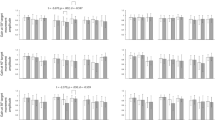Abstract
We investigated the effect of neck-shortening on prosaccade reaction time formed through saccadic training accompanied by maintenance of neck flexion. The subjects were 30 university students who exhibited no significant shortening of prosaccade reaction time during maintenance of neck flexion, assigned to three groups: prosaccade training subjects at rest neck position (rest training group); prosaccade training subjects at 20° neck flexion position (neck training group); and untrained subjects (control group). Saccadic training for 1 min was performed ten times per day, and the training period was 14 days. For the control group, no significant postural or training effects on reaction time were found. For both training groups, reaction time at the rest position after training was significantly shorter than that before training. For the neck training group, reaction time after training was significantly shorter at the neck flexion position than at the rest position. Conversely, no significant neck effect was found for the rest training group. This indicates that the shortening effect associated with maintenance of neck flexion on prosaccade reaction time is formed through saccadic training accompanied by maintenance of neck flexion.



Similar content being viewed by others
References
Berthoz A (1996) The role of inhibition in the hierarchical gating of executed and imagined movements. Brain Res Cogn Brain Res 3:101–113
Ciuffreda KJ, Han Y, Kapoor N, Ficarra AP (2006) Oculomotor rehabilitation for reading in acquired brain injury. NeuroRehabilitation 21:9–21
Dyckman KA, McDowell JE (2005) Behavioral plasticity of antisaccade performance following daily practice. Exp Brain Res 162:63–69
Fischer B, Ramsperger E (1986) Human express saccades: effects of randomization and daily practice. Exp Brain Res 64:569–578
Fischer B, Boch R, Ramsperger E (1984) Express-saccades of the monkey: effect of daily training on probability of occurrence and reaction time. Exp Brain Res 55:232–242
Fujiwara K (1994) ‘The ready’ posture and the speed of responding movements. Jpn J Sports Sci 13:739–749
Fujiwara K, Kunita K, Toyama H (2000) Changes in saccadic reaction time while maintaining neck flexion in men and women. Eur J Appl Physiol 81:317–324
Fujiwara K, Kunita K, Toyama H, Miyaguchi A (2001) Saccadic reaction times during isometric voluntary contraction of the shoulder girdle elevators and vibration stimulation to the trapezius. Eur J Appl Physiol 85:527–532
Fujiwara K, Kunita K, Toyama H (2003) Latency of saccadic eye movement during contraction of bilateral and unilateral shoulder girdle elevators. Percept Mot Skills 96:173–184
Fujiwara K, Shigeiwa M, Maeda K, Kunita K (2005) Changes in posterior auricular muscle response and middle-latency brain potential evoked by auditory stimuli according to neck flexion. Health Behav Sci 3:69–77
Fujiwara K, Kunita K, Watanabe H (2006) Sports exercise effect on shortening of saccadic reaction time associated with neck extensor muscle activity. Int J Sports Med 27:792–797
Fujiwara K, Tomita H, Maeda K, Kunita K (2009a) Effects of neck flexion on contingent negative variation and anticipatory postural control during arm movement while standing. J Electromyogr Kinesiol 19:113–121
Fujiwara K, Kunita K, Furune N (2009b) Effect of vibration stimulation to neck extensor muscles on reaction time in various saccadic eye movements. Int J Neurosci (in press)
Grantyn A, Berthoz A (1987) Reticulo-spinal neurons participating in the control of synergic eye and head movements during orienting in the cat. I. Behavioral properties. Exp Brain Res 66:339–354
Howorth B (1946) Dynamic posture. J Am Med Assoc (Chicago) 131:1398–1404
Jones BE (2003) Arousal systems. Front Biosci 8:s438–s451
Jones BE (2008) Modulation of cortical activation and behavioral arousal by cholinergic and orexinergic systems. Ann N Y Acad Sci 1129:26–34
Kapoor N, Ciuffreda KJ, Han Y (2004) Oculomotor rehabilitation in acquired brain injury: a case series. Arch Phys Med Rehabil 85:1667–1678
Kunita K, Fujiwara K (1996) Relationship between reaction time of eye movement and activity of the neck extensors. Eur J Appl Physiol Occup Physiol 74:553–557
Kunita K, Fujiwara K (1998) Diurnal fluctuations in the decrease of saccadic reaction time during maintaining the neck in flexion. Jpn J Physiol 48:S156
Kunita K, Fujiwara K (2004) Changes in the P100 latency of the visual evoked potential and the saccadic reaction time during isometric contraction of the shoulder girdle elevators. Eur J Appl Physiol 92:421–424
Leach JCD, Carpenter RHS (2001) Saccadic choice with asynchronous targets: evidence for independent randomisation. Vision Res 41:3437–3445
Michell AW, Xu Z, Fritz D, Lewis SJG, Foltynie T, Williams-Gray CH, Robbins TW, Carpenter RHS, Barker RA (2006) Saccadic latency distributions in Parkinson’s disease and the effects of l-dopa. Exp Brain Res 174:7–18
Schiff ND (2008) Central thalamic contributions to arousal regulation and neurological disorders of consciousness. Ann N Y Acad Sci 1129:105–118
Shimura K, Kasai T (2002) Effects of proprioceptive neuromuscular facilitation on the initiation of voluntary movement and motor evoked potentials in upper limb muscles. Hum Mov Sci 21:101–113
Siegel J (2002) The neural control of sleep and waking. Springer, New York
Taniguchi R, Nakamura R, Yokochi F, Narabayashi H (1980) Effects of postural change of the shoulder on EMG reaction time of triceps brachii. Appl Neurophysiol 43:40–47
Vallar G, Rusconi ML, Barozzi S, Bernardini B, Ovadia D, Papagno C, Cesarani A (1995) Improvement of left visuo-spatial hemineglect by left-sided transcutaneous electrical stimulation. Neuropsychologia 33:73–82
Author information
Authors and Affiliations
Corresponding author
Rights and permissions
About this article
Cite this article
Kunita, K., Fujiwara, K. Neck-shortening effect on prosaccade reaction time formed through saccadic training accompanied by maintenance of neck flexion. Eur J Appl Physiol 107, 597–602 (2009). https://doi.org/10.1007/s00421-009-1174-7
Accepted:
Published:
Issue Date:
DOI: https://doi.org/10.1007/s00421-009-1174-7




